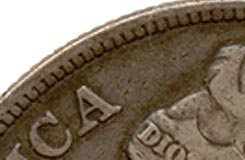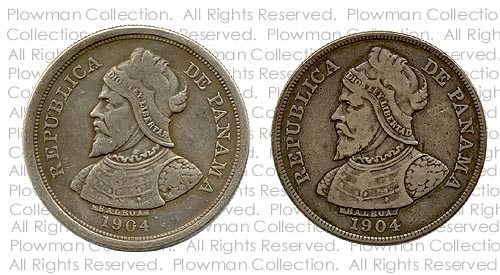| Obverse Design | Almost identical to a legitimate 1904 50 Centesimos. The legend along the left side says "REPUBLICA" and on the right says "DE PANAMA" which means "REPUBLIC OF PANAMA". The center of the coin has the bust of Vasco Nunez de Balboa, the Spanish explorer who settled in Panama and discovered the Pacific Ocean. Balboa is wearing a soft cap with a feather and armour. Immediately below Balboa and attached to his bust is a small rectangle with his name "BALBOA". Along the bottom is the date, "1904". The coin has a broad rim with small beads along the edge. | |||||
| Reverse Design | Almost identical to a legitimate 1904 50 Centesimos. The central design is the coat of arms of Panama. Panama's coat of arms is divided into two cantons at the top, two cantons at the bottom and a double wide canton in the center. The upper left canton is a crossed rifle and sword. It originally meant "Good bye forever to civil wars, cause of our ruin". In 1914 the meaning was changed to "Attitude of alertness in defense of our sovereignty." The upper right is a crossed hoe and shovel refering to the labor required to build the republic. The lower left is a cornucopia horn of plenty symbolizing richness and agriculture. The lower right has a wheel with wings symbolizing the speed of progress. The center canton shows land (the isthmus of Panama) between two oceans (the Atlantic and Pacific) with a sea level canal between the oceans. The sun is setting on the mountains in the west and the moon is rising over the waves in the east. This represents the solemn hour of Panama's declaration of independence from Columbia in 1903. An eagle with spread wings, wingtips going up, is standing on the shield which has the coat of arms. It holds a banner in its mouth which is draped along the upper edge of the shield. The banner has the latin motto "PRO MUNDI BENEFICIO" meaning "FOR THE BENEFIT OF THE WORLD" and referring to the Panama Canal. Along the upper edge of the coin from the left side to the right side is the legend "CINCUENTA CENTESIMOS DE BALBOA" which means "FIFTY CENTS OF BALBOA". Along the bottom edge is the legend "G.25. LEY 0.900" "G." is an abbreviation for grams, and the legend means that the coin weighs 25 grams. "LEY" means "LAW" and the legend means that the coin is .900 pure silver by law. Of course, this counterfeit is lead or some other metal. The coin has a broad rim with small beads along the edge. The reverse was originally designed by ... | |||||
| Comparison |
This counterfeit was probably made from a cast of a genuine coin. All the features are exactly correct, although appearing somewhat worn. Under magnification the surface appears rough and the edges of the letters are not sharp. The easiest way to spot this counterfeit is the extra broad rims and the diameter. The counterfeit is 38mm in diameter and the genuine coin is 36 mm. The difference is all in the size of the rims. As well, the geniune coin has dentures that go up to the rim of the coin. The counterfeit has a break before the rim which make the dentures appear more like a circle of small beads. |
|||||
| Detail On Counterfeit | Detail On Genuine | |||||

Note how wide the rim is, and how the dentures do not attach to the rim. Instead they appear more like beads. |

Note the narrow rim and how the dentures are attached to the rim. | |||||
| Metal | Unknown. | Size and Shape | Round, 38 mm in diameter (genuine coin is 36 mm). | Weight | 20.39 grams (geniune coin is about 25 grams, 24.78 in the case of the one coin shown on this page). | |
| Rarity | Very Rare. This is the only example I known to me. | |||||
| Source | Plowman Collection. | |||||
| Notes |
I would appreciate e-mail from anyone who can add anything to this information. |
|||||
The Coin on the Right is Genuine


Scale: 6 pixels equals one millimeter